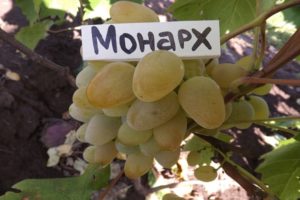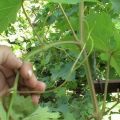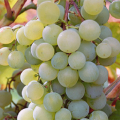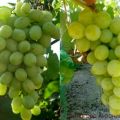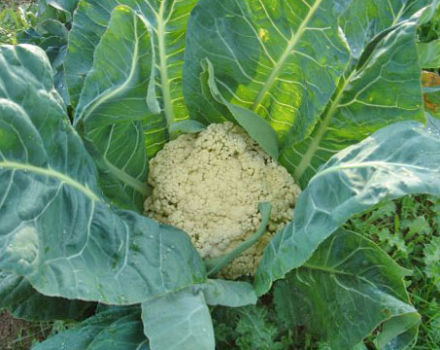Description and subtleties of growing Everest grapes
Everest grapes are a hybrid from Russian breeders that are gradually becoming popular. Differs in large sweet berries, fast growth, fruits ripen in the third year. Was bred from 2 varieties: Talisman and K-81. The fruits of the culture contain organic acids, pectin and tannins, vitamins, microelements. They eat fresh berries, prepare compotes, syrups, juices, fruit drinks, jellies, jams.
Description and characteristics of the variety
Everest took all the best qualities from the original varieties - large berry sizes, beautiful appearance, great taste, immunity to fungal diseases and pest attacks.
Bushes
Medium early grape variety, characterized by high survival rate, vigor of growth and ripening along the entire length. Leaf plates are openwork, heart-shaped, large, five-lobed, dissected. From the time the buds appear until the fruit ripens, it takes 110-120 days.
Flowers
Flowers are hermaphrodite, capable of pollinating themselves. The variety participates in the pollination of other plants with unisex flowers. The ovaries are recommended to be thinned out to obtain large berries.
Bunches and berries
Cone-shaped or cylindrical bunches of grape varieties have:
- attractive presentation;
- medium density;
- large size;
- weighing 500-800 g.
Juicy and firm berries are oval, 4.5 cm long, weighing 18-20 g. Pink at the beginning of ripening, then red-violet with a dense waxy bloom. There are 2 seeds each, they are easily separated when pressed. With inadequate care, large and small berries ripen on one vine. The variety has a sweet taste, without the presence of sourness and nutmeg aftertaste.
This variety is not recommended for wine.
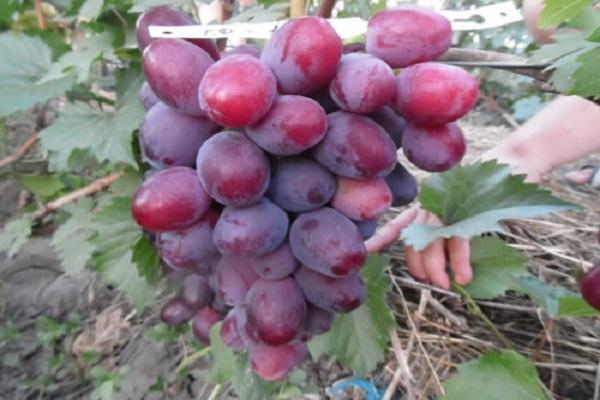
Yield
The yield is high, at least 25 kg of bunches are harvested from the bush. Gardeners breed the Everest variety for personal use and for sale. Harvesting begins in mid or late August, the period depends on the region.
Transportability
The grape skin protects the fruit from damage and external factors. Thanks to her, the variety tolerates excellent transportation over long distances and is stored for a long time.
Frost resistance
The variety tolerates frosts in the southern and middle regions. Otherwise, frost resistance is not fully understood. The bushes need to be covered for the winter, especially if the temperature reaches -20 C. This will give guarantees of obtaining the future harvest of berries.
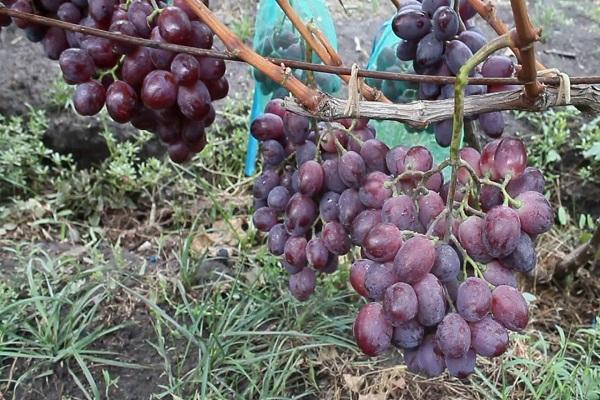
Disease and pest resistance
The variety is resistant to fungal diseases, pests, is not afraid of the invasion of wasps. Only preventive treatments are carried out.
Advantages and disadvantages of Everest grapes
The derived table form of the variety has many advantages:
- After ripening, the brush can be left on for another month.
- The taste of the berries is improved.
- Transportable for a long distance.
- There is no cracking, shedding of berries, clusters are stored for up to 3 months.
- Nice presentation.
- Ability to adapt to different climates.
- The cuttings take root quickly.
Among the disadvantages are the high cost of seedlings and the unconfirmed instability of the variety to low temperatures.
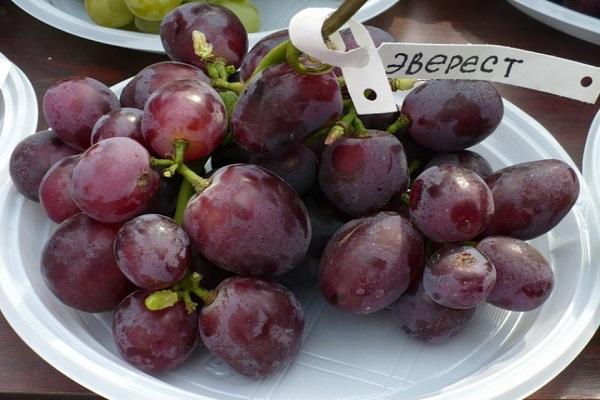
The specifics of growing crops
To form large and sweet berries, you should know the principles of cultivation and care.
Selection and preparation of the landing site
Choose a sunny, windless place for planting, with light, fertile soil. In a shady area, the bushes grow slowly, the berries will be savory. The best site is a slope, a hill. In areas with a cold climate - a place on the south side. Fruit trees must grow more than 3 m apart.
Preparation of planting material
Everest saplings are still not widespread, it is advisable to take them in a nursery. The cuttings should be healthy, without cracks and spots, growths on the roots. 40 cm long, 5-7 mm thick, 2-3 buds. Before planting, they are soaked in humate, the ends are trimmed.
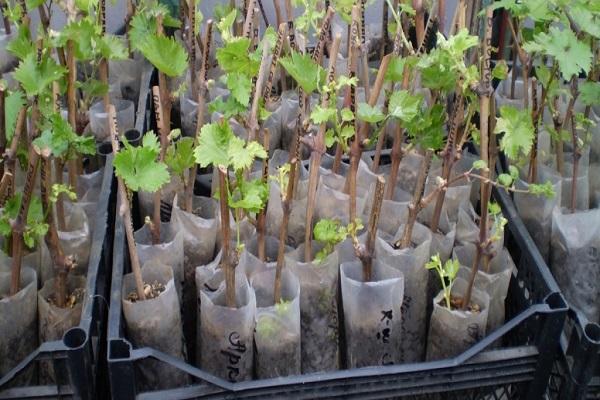
Work order
The crop is planted preferably in October, in early spring, after the snow has melted. They dig a hole 60 x 60 wide and 60 cm deep, drainage from rubble, expanded clay is poured onto the bottom. The soil is mixed with humus, wood ash. The landing hole is filled up, covered with a film. Can be planted after 3 weeks. On the north side, a support is placed to support the vine. The planting material is set in the middle of the hole, covered with soil, tamped, watered.
To enrich the soil, the following method is used - in the spring they sow the area with peas, and in the fall they drop it by 20 cm.
Plant care rules
Subject to agricultural technology, it is possible to collect a rich harvest from a new variety.
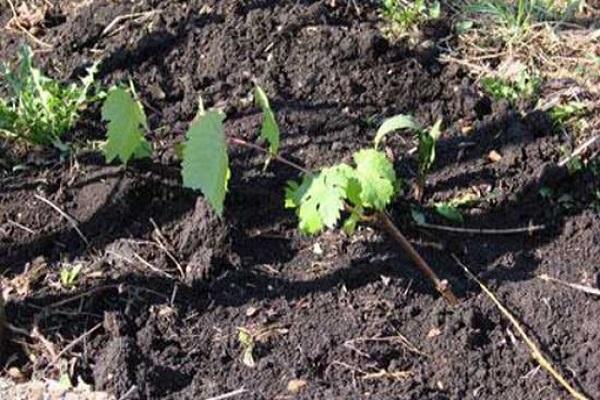
Bush formation and pruning
In the spring, the frozen parts of the bush are removed. In autumn, when pruning, 5 strong shoots are left on a separate bush, which are cut off annually by 8-10 eyes. Secondary stepchildren, weak bunches, excess leaves are removed. In the summer, the tops are pinched.
Watering
Young bushes are watered more often than adults. Plants that have reached 3 years of age are watered in the spring, before bud break, then before flowering and when clusters form. Watering is not recommended during flowering and before removing berries.
The water should be kept warm. In this case, moisture stagnation should not be allowed. In late autumn, if there was no rain, mature bushes should be watered abundantly to increase cold resistance.
Watering can be carried out together with top dressing, it is diluted in water. After that, mulching of the soil should be done to retain moisture.
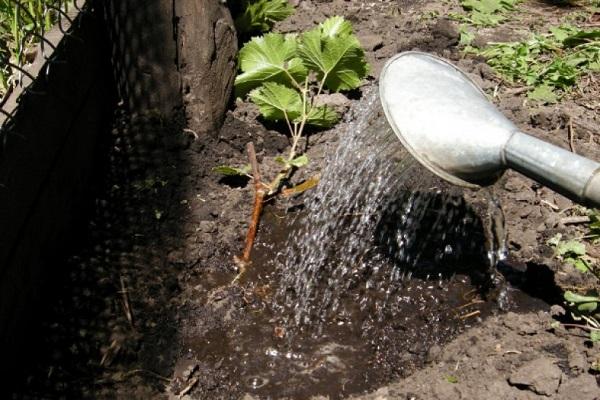
Fertilizing and feeding
In the spring, urea or ammonium nitrate is introduced - 40-50 g per bush. After the formation of ovaries, fertilizers containing phosphorus and potassium are needed. In autumn they are fed with mineral complexes. Manure is applied every 2-3 years.
Shelter for the winter
In areas with low winter temperatures, the bushes should be insulated. Lay the folded vine on the boards, cover it with special material or dry sawdust on top. On top, make a layer of film to protect it from moisture.

Protection against diseases and pests
For the entire season, the bushes are sprayed with fungicides 2-3 times for prevention. In the spring, the soil and plants are sprayed with a solution of copper sulfate.Antifungal drugs are treated until the second leaf appears. And again together with insecticides before flowering. They use Topaz, Aktellik, Tiovit Jet, Horus.
If the plant has been exposed to diseases or pests, it is treated with appropriate chemicals.
Harvesting and storage
The collection of the variety is carried out as it ripens, in different regions dates from the second half of August to the end of September. You need to collect the bunches during the day, in clear weather, immediately transferring the berries to the shade. Damaged, dry, unripe, rotten fruits are removed.
The storage room needs to be well ventilated, without mold, if the air temperature drops below zero, the crop is insulated. The hands tied with twine are placed on a stretched wire, rope.

Wooden boxes are another storage option. Spread the bunches on a layer of sawdust 2-3 cm thick so that the berries do not touch each other. Sawdust from linden, poplar, but not coniferous trees. Then another layer of grapes and sawdust, cover loosely. So it can be stored for up to 3 months. You can also put straw in boxes, clean paper, then grapes in one layer, the berries will lie for 2 months. Inspect and remove spoiled berries regularly.

